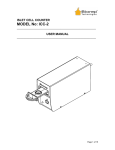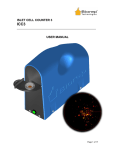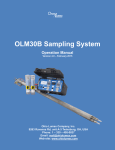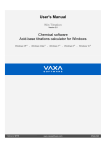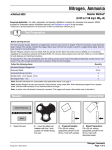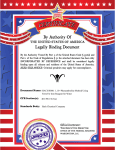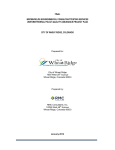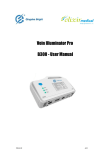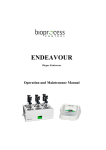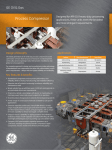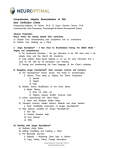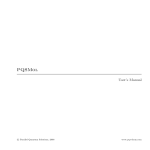Download Silver
Transcript
Silver Colorimetric Method Method 8120 Powder Pillows (0.005 to 0.700 mg/L) Scope and Application: For water and wastewater. Test Preparation Before starting the test: Digestion is required for samples with interferences. See Digestion on page 5. For more accurate results, determine a reagent blank value for each new lot of reagent. Follow the procedure using deionized water instead of the sample. Subtract the reagent blank value from the final results or perform a reagent blank adjust. The graduated cylinder must be completely dry before beginning the test. If the Silver 1 Powder becomes moist, it will not dissolve completely, which will inhibit color development. The sample pH for this test must be between 9 and 10. Do not use a pH meter to adjust the sample pH as it will cause contamination. See Digestion on page 5 for the procedure to adjust pH. Generate a blank for each sample. Collect the following items: Quantity Silver 1 Reagent Powder Pillow 1 Silver 2 Reagent Powder Pillow 1 Sodium Thiosulfate Powder Pillow 1 Clippers 1 Cylinder, graduated, 50-mL 1 Cylinder, graduated mixing, 50-mL 1 Sample Cells, 10-mL square, 1-inch 2 Note: Reorder information for consumables and replacement items is on page 7. Silver_8120_PP.fm Silver Page 1 of 8 Silver (0.005 to 0.700 mg/L) Powder Pillows 1. Select the test. Method 8120 2. Insert the Multi-cell Adapter with the 1-inch square cell holder facing the user. 3. Add the contents of one Silver 1 Powder Pillow to a dry 50-mL graduated mixing cylinder. If the Silver 1 Powder becomes wet at this point, the powder will not dissolve completely, which will inhibit color development. 5. Use a 50-mL graduated cylinder to add 50 mL of sample to the 50-mL graduated mixing cylinder. Stopper and invert repeatedly for one minute. Silver Page 2 of 8 6. Prepared Sample: Fill a square sample cell to the 10-mL mark with the mixture. 7. Blank Preparation: Discard all but 25-mL of the sample from step 5. 4. Add the contents of one Silver 2 Reagent Solution Pillow to the cylinder. Swirl to completely wet the powder. If clumps of dry powder are present when the sample is poured in, the powder will not dissolve completely, which will inhibit color development. 8. Add the contents of one Sodium Thiosulfate Reagent Powder Pillow to the remaining 25-mL of sample. Stopper and invert to mix. Silver_8120_PP.fm Silver (0.005 to 0.700 mg/L) 9. Press TIMER>OK. A two-minute reaction period will begin. 10. Pour 10 mL of the blank into a second square sample cell. 11. When the timer expires, insert the blank into the cell holder with the fill line facing the user. 12. Press ZERO. The display will show: 0.000 mg/L Ag 13. insert the prepared sample into the cell holder with the fill line facing the user. Results are in mg/L Ag. Interferences Interference studies were conducted by preparing a known silver solution (about 0.4 mg/L) and the potential interfering ion. The ion was said to interfere when the resulting concentration changed by ±10%. Table 1 Interfering Substances and Levels Interfering Substance Interference Levels Aluminum Negative interference above 30 mg/L Ammonia Negative interference above 750 mg/L Cadmium Negative interference above 15 mg/L Calcium Positive interference above 600 mg/L Chloride Negative interference above 19 mg/L Chromium6+ Negative interference above 90 mg/L Copper Negative interference above 7 mg/L Iron Negative interference above 30 mg/L Lead Negative interference above 13 mg/L Manganese Negative interference above 19 mg/L Silver_8120_PP.fm Silver Page 3 of 8 Silver (0.005 to 0.700 mg/L) Table 1 Interfering Substances and Levels (continued) Interfering Substance Interference Levels Magnesium Positive interference above 2000 mg/L Mercury Positive interference above 2 mg/L Nickel Negative interference above 19 mg/L Zinc Negative interference above 70 mg/L Sample Collection, Storage, and Preservation Collect samples in acid-cleaned glass or plastic bottles. Using pH paper, adjust the pH to 2 or less with concentrated Nitric Acid* (about 2 mL/liter). Store preserved samples at room temperature for up to 6 months. If the sample contains particulates or only dissolved metal content is being determined, filter through a 0.45 µm filter at collection. After filtration, adjust the pH to 2 or less as described above for storage. Before analysis, adjust the pH to 9–10 with 5.0 N Sodium Hydroxide*. (See steps 13–14 of Digestion on page 5.) Do not use a pH meter because of silver contamination from the electrode. Accuracy Check Standard Additions Method (Sample Spike) 1. After reading test results, leave the sample cell (unspiked sample) in the instrument. 2. Press OPTIONS>MORE. Press STANDARD ADDITIONS. A summary of the standard additions procedure will appear. 3. Press OK to accept the default values for standard concentration, sample volume, and spike volumes. Press EDIT to change these values. After values are accepted, the unspiked sample reading will appear in the top row. See the user manual for more information. 4. Add 5.00 mL of 1000 mg/L Silver Standard Solution to a 100-mL volumetric Class A flask. Dilute to volume with deionized water. This is a 50.0 mg/L standard solution. 5. Prepare three sample spikes. Fill three mixing cylinders* with 50-mL of sample. Use the TenSette® Pipet to add 0.1 mL, 0.2 mL, and 0.3 mL of standard, respectively, to each sample and mix thoroughly. 6. Analyze each sample spike as described in the procedure above, starting with the 0.1 mL sample spike. Accept each standard additions reading by pressing READ. Each addition should reflect approximately 100% recovery. 7. After completing the sequence, press GRAPH to view the best-fit line through the standard additions data points, accounting for matrix interferences. Press IDEAL LINE to view the relationship between the sample spikes and the “Ideal Line” of 100% recovery. * See Optional Reagents and Apparatus on page 7. Silver Page 4 of 8 Silver_8120_PP.fm Silver (0.005 to 0.700 mg/L) Standard Solution Method Prepare a 0.5 mg/L silver standard solution as follows: 1. Pipet 0.50 mL of Silver Standard Solution, 1000 mg/L, into a 1000-mL volumetric flask using a Class A volumetric pipet. Dilute to the mark with deionized water. Prepare this solution daily. Perform the silver procedure as described above. 2. To adjust the calibration curve using the reading obtained with the 0.5-mg/L silver standard solution, press OPTIONS>MORE on the current program menu. Press STANDARD ADJUST. 3. Press ON. Press OK to accept the displayed concentration. If an alternate concentration is used, press the number to enter the actual concentration. Press OK. Press ADJUST. Method Performance Precision Standard: 0.500 mg/L Ag Program 95% Confidence Limits of Distribution 660 0.488–0.512 mg/L Ag Sensitivity Portion of Curve ∆Abs ∆Concentration Entire range 0.010 0.005 mg/L Ag Digestion This digestion is for samples containing organic matter, thiosulfate or cyanide. Possible sources for these compounds are wastewater, silver electroplating baths and silver strike solutions. Digestion should be done with a Digesdahl Digestion Apparatus. DANGER Perform this digestion under a fume hood. Poisonous hydrogen cyanide gas may be generated. CAUTION Always wear safety glasses and use a safety shield, or operate the Digesdahl within a closed fume hood. Follow the additional safety precautions in the Digesdahl Digestion Apparatus Manual. 1. Add an appropriate size sample to the 100-mL digestion flask for use with the Digesdahl. Add several boiling chips to prevent bumping. Note: Appropriate sample size is determined experimentally. The final sample concentration (after dilution to 100 mL) should be 0–0.6 mg/L. Larger dilutions may be necessary for electroplating baths and silver strike solutions. Do not exceed the maximum sample volume of 25 mL. Several 25-mL aliquots may be digested in succession to concentrate a very dilute sample. 2. Turn on the water aspirator and make sure there is suction in the fractionating head. 3. Add 3 mL of concentrated sulfuric acid to the sample in the volumetric flask. Immediately place the head on the digestion flask. Never use less than 3 mL of acid. Silver_8120_PP.fm Silver Page 5 of 8 Silver (0.005 to 0.700 mg/L) 4. Place the digestion flask on the heater. Turn the temperature dial to 440 °C (825 °F). 5. After the sample begins to char or the sulfuric acid reflux line becomes visible, wait 3–5 minutes. 6. Visually confirm the presence of acid in the flask before adding hydrogen peroxide! 7. Add 10 mL of 50% hydrogen peroxide to the sample via the capillary funnel in the fractionating head. 8. After the hydrogen peroxide has boiled off, heat the sample until heavy white sulfuric acid fumes are present. Continue heating and reduce the sample volume to near dryness. Do not let the sample go completely dry at any time. Note: If the sample evaporates, turn the Digesdahl off and cool completely. Add water to flask before handling. Repeat digestion from the beginning. Note: If only thiosulfate is present in the sample, proceed to step 1 of the Colorimetric procedure. 9. Add another 3 mL of sulfuric acid via the capillary funnel. 10. Add another 5 mL of hydrogen peroxide. Check the solution for digestion completion. If digestion is not complete, continue adding hydrogen peroxide in 5 to 10 mL portions. Several portions may be necessary. Note: Digestion is complete when the digestate is colorless or the color of the digestate does not change upon addition of hydrogen peroxide. Also, a completely digested sample will not foam. 11. After digestion is complete and all the hydrogen peroxide is boiled off, reduce the volume of the digestate to near dryness. Do not allow the sample to become completely dry. Remove the flask from the heater. Cool to room temperature. 12. Slowly add about 25 mL of deionized water to the cooled flask. 13. Add 2 drops of 1 g/L Phenolphthalein Indicator Solution. Add 2 drops of 1 g/L Thymolphthalein Indicator Solution. 14. Using sodium hydroxide, adjust the pH of the solution to 9–10. The solution will be pink in this pH range. Note: A purple color indicates a pH greater than 10. If this occurs, add a drop of sulfuric acid and 2 drops of each indicator; repeat pH adjustment. Initially, use 50% sodium hydroxide, then 1 N sodium hydroxide as the end point is approached. 15. Filter turbid digestates. Quantitatively transfer the filtrate (or unfiltered sample) to a clean 100-mL volumetric flask. Dilute to the mark with deionized water. The sample is ready for analysis. Summary of Method Silver ions in basic solution react with cadion 2B to form a green to brown to red-purple complex. The sodium thiosulfate acts as a decolorizing agent for the blank. The Silver 1 and Silver 2 reagents contain the buffer, indicator, and masking agents. Organic extractions are not necessary and this method does not have as many interferences as the traditional dithizone method. Test results are measured at 560 nm. Silver Page 6 of 8 Silver_8120_PP.fm Silver (0.005 to 0.700 mg/L) Consumables and Replacement Items Required Reagents Description Quantity/Test Unit Silver Reagent Set (50 tests), includes: Silver 1 Reagent Powder Pillow Cat. No. 22966-00 1 50/pkg 22935-66 Silver 2 Reagent Solution Pillow 1 50/pkg 22936-66 Sodium Thiosulfate Powder Pillow 1 50/pkg 22937-66 Quantity/Test Unit Cat. No. Clippers 1 each 968-00 Cylinder, graduated, 50-mL 1 each 21179-41 Cylinder, graduated, mixing, 50-mL 1 each 1896-41 Sample Cells, 1-inch square, 10 mL, matched pair 2 2/pkg 24954-02 Unit Cat. No. Required Apparatus Description Digestion Reagents and Apparatus Description Hydrogen Peroxide, 50% Phenolphthalein Indicator Solution, 1 g/L Sodium Hydroxide Solution, 50% Sodium Hydroxide Solution, 1.00 N Sulfuric Acid, ACS, concentrated Thymolphthalein Indicator Solution, 1 g/L Water, deionized Boiling Chips, silicon carbide 490 mL 21196-49 15 mL SCDB 1897-36 500 mL 2180-49 100 mL MDB 1045-32 2.5 L 979-09 15 mL SCDB 21853-36 4L 272-56 500 g 20557-34 Digesdahl Digestion Apparatus, 115 V ac, 50/60 Hz each 23130-20 Digesdahl Digestion Apparatus, 230 V ac, 50/60 Hz each 23130-21 Safety Shield, for Digesdahl each 50030-00 Recommended Standards Description Unit Cat. No. 100 mL 14613-42 4L 272-56 Unit Cat. No. Cylinder, mixing 50 mL 1896-41 Nitric Acid, concentrated ACS 500 mL 152-49 Sodium Hydroxide, 5.0 N 100 mL 2450-32 Silver Standard Solution, 1000 mg/L Ag Water, deionized Optional Reagents and Apparatus Description Silver_8120_PP.fm Silver Page 7 of 8 FOR TECHNICAL ASSISTANCE, PRICE INFORMATION AND ORDERING: In the U.S.A. – Call toll-free 800-227-4224 Outside the U.S.A. – Contact the HACH office or distributor serving you. On the Worldwide Web – www.hach.com; E-mail – [email protected] © Hach Company, 2005. All rights reserved. Printed in Germany. HACH COMPANY WORLD HEADQUARTERS Telephone: (970) 669-3050 FAX: (970) 669-2932 Updated April 05 Edition 1









